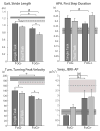Dual task interference on postural sway, postural transitions and gait in people with Parkinson's disease and freezing of gait
- PMID: 28521148
- PMCID: PMC5714292
- DOI: 10.1016/j.gaitpost.2017.05.006
Dual task interference on postural sway, postural transitions and gait in people with Parkinson's disease and freezing of gait
Abstract
Freezing of gait (FoG) is associated with less automatic gait and more impaired cognition, balance and postural transitions compared to people with PD who do not have FoG. However, it is unknown whether dual-task cost during postural sway, postural transitions (such as gait initiation and turning), and gait are more in subjects with Parkinson's disease (PD) who have freezing of gait (FoG+) compared to those who do not have FoG (FoG-). Here, we hypothesized that the effects of a cognitive dual task on postural sway, postural transitions and gait would be larger in FoG+ than FoG-. Thirty FoG- and 24 FoG+ performed an Instrumented Stand and Walk test in OFF medication state, with and without a secondary cognitive task (serial subtraction by 3s). Measures of postural sway, gait initiation, turning, and walking were extracted using body-worn inertial sensors. FoG+ showed significantly larger dual task cost than FoG- for several gait metrics, but not during postural sway or postural transitions. During walking, FoG+ exhibited a larger dual task cost than FoG- resulting in shorter stride length and slower stride velocity. During standing, FoG+ showed a larger postural sway compared to FoG- and during gait initiation, FoG+, but not FoG-, showed a longer first step duration during the dual-task condition compared to single-task condition (interaction effect, p=0.04). During turning, both groups showed a slower turn peak speed in the dual-task condition compared to single task condition. These findings partly support our hypothesis that dual task cost on walking is greater in FoG+ than FoG-.
Keywords: Anticipatory postural adjustments; Dual task; Freezing of gait; Gait; Parkinson’s disease.
Copyright © 2017. Published by Elsevier B.V.
Conflict of interest statement
OHSU and Dr. Horak have a significant financial interest in, and are employees of ADPM, a company that has a commercial interest in the results of this research and technology. This potential institutional and individual conflict has been reviewed and managed by OHSU and the VA Portland Health Care System.
Figures

References
MeSH terms
Grants and funding
LinkOut - more resources
Full Text Sources
Other Literature Sources
Medical

